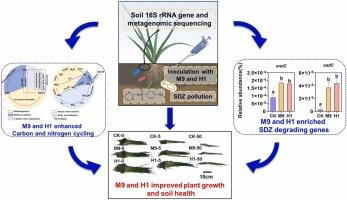磺胺嘧啶降解菌的生物修复潜力:对黑麦草生长和土壤功能的影响
IF 11.3
1区 环境科学与生态学
Q1 ENGINEERING, ENVIRONMENTAL
引用次数: 0
摘要
抗生素(尤其是磺胺嘧啶(SDZ))的广泛使用导致了严重的环境污染和抗生素耐药基因(ARGs)的扩散。本研究调查了两株降解 SDZ 的细菌--不动杆菌 M9 和肠杆菌 H1 的生物修复潜力,以及它们对黑麦草(Lolium perenne)生长和 SDZ 污染土壤中根际微环境的影响。盆栽实验结合扩增子和元基因组测序发现,接种 M9 和 H1 菌株可缓解氧化应激,增加叶绿素含量,改善土壤养分供应,从而显著促进黑麦草的生长。这些菌株还能促进 SDZ 降解效率,并通过上调关键功能基因改善碳氮循环。此外,微生物群落分析表明,α多样性增加,优势类群发生变化,污染物降解途径功能丰富。ARGs的动态变化表明,氨基糖苷类、利福霉素和链霉素抗性基因减少了,而磺胺类抗性基因则由于残留的SDZ压力而增加了。这些发现凸显了 M9 和 H1 作为可持续生物修复剂在减轻抗生素污染、改善土壤健康和支持污染环境中植物生长方面的潜力。本文章由计算机程序翻译,如有差异,请以英文原文为准。

Bioremediation Potential of Sulfadiazine-Degrading Bacteria: Impacts on Ryegrass Growth and Soil Functionality
The extensive use of antibiotics, particularly sulfadiazine (SDZ), has led to significant environmental contamination and the proliferation of antibiotic resistance genes (ARGs). This study investigates the bioremediation potential of two SDZ-degrading bacterial strains, Acinetobacter sp. M9 and Enterobacter sp. H1, and their impact on ryegrass (Lolium perenne) growth and the inter-root microenvironment in SDZ-contaminated soils. A pot experiment combined with amplicon and metagenomic sequencing revealed that inoculation with M9 and H1 significantly enhanced ryegrass growth by alleviating oxidative stress, increasing chlorophyll content, and improving soil nutrient availability. The strains also promoted SDZ degradation efficiency and improved carbon and nitrogen cycling through the upregulation of key functional genes. Furthermore, microbial community analysis demonstrated increased alpha diversity, shifts in dominant taxa, and functional enrichment in pollutant degradation pathways. The dynamics of ARGs revealed a decrease in aminoglycoside, rifamycin, and streptomycin resistance genes, while sulfonamide resistance genes increased due to the residual SDZ stress. These findings highlight the potential of M9 and H1 as sustainable bioremediation agents to mitigate antibiotic contamination, improve soil health, and support plant growth in polluted environments.
求助全文
通过发布文献求助,成功后即可免费获取论文全文。
去求助
来源期刊

Journal of Hazardous Materials
工程技术-工程:环境
CiteScore
25.40
自引率
5.90%
发文量
3059
审稿时长
58 days
期刊介绍:
The Journal of Hazardous Materials serves as a global platform for promoting cutting-edge research in the field of Environmental Science and Engineering. Our publication features a wide range of articles, including full-length research papers, review articles, and perspectives, with the aim of enhancing our understanding of the dangers and risks associated with various materials concerning public health and the environment. It is important to note that the term "environmental contaminants" refers specifically to substances that pose hazardous effects through contamination, while excluding those that do not have such impacts on the environment or human health. Moreover, we emphasize the distinction between wastes and hazardous materials in order to provide further clarity on the scope of the journal. We have a keen interest in exploring specific compounds and microbial agents that have adverse effects on the environment.
 求助内容:
求助内容: 应助结果提醒方式:
应助结果提醒方式:


